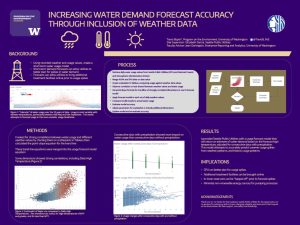Increasing Water Demand Forecast Accuracy through the Inclusion of Weather Data
Municipal water utilities can improve efficiencies using short-term demand forecasting. These short-term forecasts can be improved by including weather factors in the forecast modeling. This project provides Seattle Public Utilities (SPU) with a model to generate a more accurate water demand forecast by factoring weather data. To do so, I merged historic SPU usage data with historic weather data as provided by the National Oceanic and Atmospheric Administration (NOAA). I charted usage against individual weather values, to look for strong correlations, and found that temperature and consecutive days with precipitation were strongly correlated with changes in water usage. I used the trendlines of these charts to build a mathematic formula that given the daily high temperature and number of prior consecutive days of rain will output a water demand forecast. I then tested this model against the historical usage values. This model returned projected demand values with an average error of about 10%, an improvement over the previously available short-term forecasts. By integrating these demand forecasts with existing processes, SPU can have early warning of leakage issues. Additionally, ideally SPU will be able to schedule energy intensive processes like groundwater pumping at a time that can make the most advantage of intermittent renewable energy sources.
